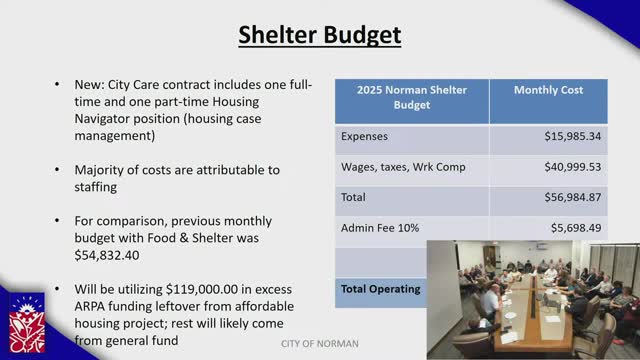Shelter leaders confront rising homelessness crisis in Oklahoma City
November 19, 2024 | Norman, Cleveland County, Oklahoma
This article was created by AI summarizing key points discussed. AI makes mistakes, so for full details and context, please refer to the video of the full meeting. Please report any errors so we can fix them. Report an error »

During a recent government meeting, officials discussed the challenges and strategies surrounding homelessness services in Oklahoma City. A key concern raised was the transient population utilizing local shelters, which some officials believe may attract individuals facing mental health and crime issues. The conversation highlighted the need for collaboration among service providers to better address these challenges.
One official expressed a desire to visit existing shelters to understand their operations and the populations they serve. The importance of attracting individuals to services rather than allowing them to remain in precarious situations, such as living in tents, was emphasized. The officials acknowledged the complexity of the issue, admitting that they do not have all the answers but are committed to improving the situation.
The meeting also touched on the operational capacity of local shelters, with one shelter currently providing 140 beds, of which a portion is reserved for families. The shelter's director noted that while the number of individuals needing services appears to be increasing, the limited capacity makes it difficult to gauge the overall demand accurately. A recent point-in-time count indicated a rise in the homeless population compared to previous years.
Funding for the shelters was another critical topic, with officials discussing the reliance on city funds and external contributions to meet an annual operating budget of approximately $1.2 million. The need for effective fundraising efforts was highlighted, with references made to partnerships with organizations like United Way.
Finally, the average duration of stay for individuals at the shelter was discussed, revealing that while many stay for a short period, some individuals remain for extended durations due to various barriers to housing. The officials are currently developing diversion systems to assist those at risk of homelessness, aiming to reduce the length of stay and improve outcomes for individuals seeking shelter.
One official expressed a desire to visit existing shelters to understand their operations and the populations they serve. The importance of attracting individuals to services rather than allowing them to remain in precarious situations, such as living in tents, was emphasized. The officials acknowledged the complexity of the issue, admitting that they do not have all the answers but are committed to improving the situation.
The meeting also touched on the operational capacity of local shelters, with one shelter currently providing 140 beds, of which a portion is reserved for families. The shelter's director noted that while the number of individuals needing services appears to be increasing, the limited capacity makes it difficult to gauge the overall demand accurately. A recent point-in-time count indicated a rise in the homeless population compared to previous years.
Funding for the shelters was another critical topic, with officials discussing the reliance on city funds and external contributions to meet an annual operating budget of approximately $1.2 million. The need for effective fundraising efforts was highlighted, with references made to partnerships with organizations like United Way.
Finally, the average duration of stay for individuals at the shelter was discussed, revealing that while many stay for a short period, some individuals remain for extended durations due to various barriers to housing. The officials are currently developing diversion systems to assist those at risk of homelessness, aiming to reduce the length of stay and improve outcomes for individuals seeking shelter.
View full meeting
This article is based on a recent meeting—watch the full video and explore the complete transcript for deeper insights into the discussion.
View full meeting
